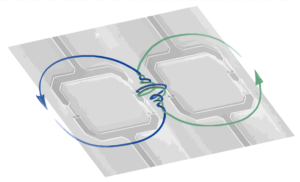All quantum computation schemes (quantum simulation, quantum annealing, adiabatic quantum computing, gate-based quantum computing…) need an appropriate platform of coherent physical qubits with large anharmonicities and strong tunable coupling between them in order to be realised. A great number of candidates for the physical implementation of quantum computers have been suggested throughout the years, such as ion traps or superconducting circuits. The focus of our work on quantum hardware is mainly directed toward the latter.
Superconducting Qubits

Superconducting qubits consist of a micro scale electrical circuit with some nonlinear element, typically a Josephson junction. This element, essentially a capacitor that allows the tunneling of Cooper pairs, offers incredible possibilities. However, there are multiple ways in which several Josephson Junctions, as well as coils and capacitors can be combined to form a qubit. Some examples are: charge qubits, three Josephson junction flux qubits, fluxonion qubits… This flexibility in the design, together with the possibility of using circuit elements to mediate interactions between them, makes superconducting circuits one of the most promising platforms for the realization of quantum computing devices. In fact, it is nowadays the supporting platform of most of the state-of-the-art implementations of quantum devices such as IBM’s gate-based quantum computer, Google’s gate-based quantum computer, or D-wave’s quantum annealer.
In this context, our group takes part in the project AVaQus (Annealing-based Variational Quantum Processors) which aims at a radical upgrade of present quantum annealing technology by engineering novel superconducting quantum circuits. AVaQus is a European project funded in the FET-Open 2019 call and brings together research groups and companies to develop a quantum processor that demonstrates coherent quantum annealing and its potential to solve real-life optimization problems. Our work here consists of theoretically designing and analyzing novel circuit architectures for quantum computing and optimization. In particular, we study the possibility of finding strong tunable interactions between three Josephson junction flux qubits and with other circuit elements for its later implementation on the construction of a real quantum annealer.
Quantum Links
We believe that superconducting circuits are a promising platform for quantum information processing, however, they have a very specific drawback: the temperatures at which they operate. Whereas with current technologies, the needed temperatures of a few miliKelvin are easily and cheaply reached, the size of the refrigerators becomes a problem when we aim to scale up the setup.

The solution that we propose for this is to implement a local area network in which we connect several refrigerators via quantum links [1]. This ambitious idea is tackled within the context of the european collaboration SuperQulan (Superconducting Quantum Local Area Network). Quinfog is in the theory division of this interdisciplinary project designing protocols for distributed quantum information processing. Among these are:
- Shaping of individual photons for state transfer and high fidelity data writing and retrieval by means of time dependent couplings.
- Implementation of a controlled phase gate and eventually of a universal set of gates between distant nodes of the network.
- Entanglement distribution.
For all of this we use quantum optical techniques such as Input-Output formalism and master equation modelization. Our mid term goal is to find a theory that takes full account of the phenomenology for both short and long links and develop a python library that can be used as a toolbox to solve problems related with any distributed setup.
Selected Group Publications
- Hita-Pérez, M., Orellana, P., García-Ripoll, J.J., Pino M. (2022). Bound states in the continuum in a heavy fluxonium qutrit. Phys. Rev. A 106, 062602.
- Peñas, G.F., Puebla, R., Ramos, T., Rabl, P., García-Ripoll, J.J. (2022). Universal Deterministic Quantum Operations in Microwave Quantum Links. Physical Review Applied 17, 054038.
- Hita-Pérez, M., Jaumà, G., Pino, M., & García-Ripoll, J.J. (2022). Ultrastrong capacitive coupling of flux qubits. Physical Review Applied 17, 014028.
- Hita-Pérez, M., Jaumà, G., Pino, M., & García-Ripoll, J.J. (2021). Three-Josephson junctions flux qubit couplings. Applied Physics Letters 119, 222601.
- Peropadre, B., Forn-Díaz, P., Solano, E., & García-Ripoll, J. J. (2010). Switchable Ultrastrong Coupling in Circuit QED. Physical Review Letters 105, 023601.